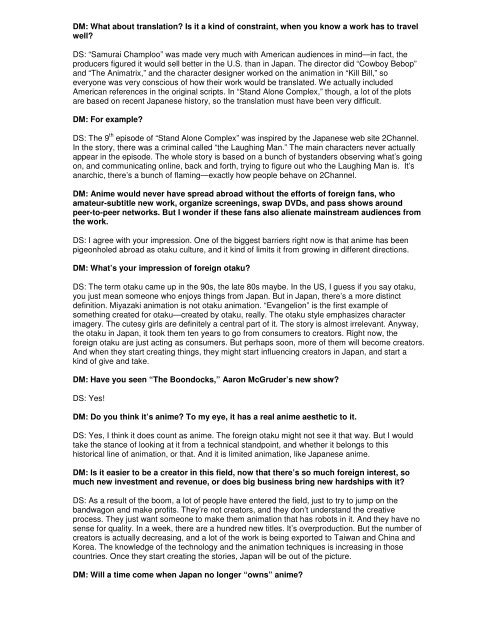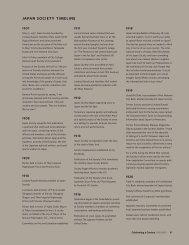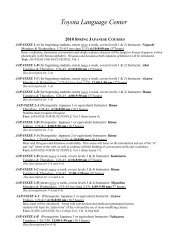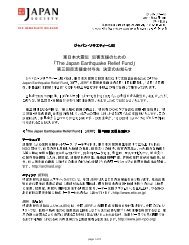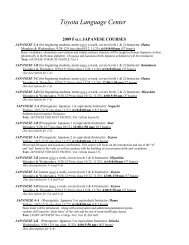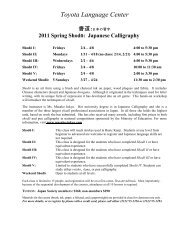Doug McGray's interview with anime screenwriter ... - Japan Society
Doug McGray's interview with anime screenwriter ... - Japan Society
Doug McGray's interview with anime screenwriter ... - Japan Society
Create successful ePaper yourself
Turn your PDF publications into a flip-book with our unique Google optimized e-Paper software.
DM: What about translation? Is it a kind of constraint, when you know a work has to travelwell?DS: “Samurai Champloo” was made very much <strong>with</strong> American audiences in mind—in fact, theproducers figured it would sell better in the U.S. than in <strong>Japan</strong>. The director did “Cowboy Bebop”and “The Animatrix,” and the character designer worked on the animation in “Kill Bill,” soeveryone was very conscious of how their work would be translated. We actually includedAmerican references in the original scripts. In “Stand Alone Complex,” though, a lot of the plotsare based on recent <strong>Japan</strong>ese history, so the translation must have been very difficult.DM: For example?DS: The 9 th episode of “Stand Alone Complex” was inspired by the <strong>Japan</strong>ese web site 2Channel.In the story, there was a criminal called “the Laughing Man.” The main characters never actuallyappear in the episode. The whole story is based on a bunch of bystanders observing what’s goingon, and communicating online, back and forth, trying to figure out who the Laughing Man is. It’sanarchic, there’s a bunch of flaming—exactly how people behave on 2Channel.DM: Anime would never have spread abroad <strong>with</strong>out the efforts of foreign fans, whoamateur-subtitle new work, organize screenings, swap DVDs, and pass shows aroundpeer-to-peer networks. But I wonder if these fans also alienate mainstream audiences fromthe work.DS: I agree <strong>with</strong> your impression. One of the biggest barriers right now is that <strong>anime</strong> has beenpigeonholed abroad as otaku culture, and it kind of limits it from growing in different directions.DM: What’s your impression of foreign otaku?DS: The term otaku came up in the 90s, the late 80s maybe. In the US, I guess if you say otaku,you just mean someone who enjoys things from <strong>Japan</strong>. But in <strong>Japan</strong>, there’s a more distinctdefinition. Miyazaki animation is not otaku animation. “Evangelion” is the first example ofsomething created for otaku—created by otaku, really. The otaku style emphasizes characterimagery. The cutesy girls are definitely a central part of it. The story is almost irrelevant. Anyway,the otaku in <strong>Japan</strong>, it took them ten years to go from consumers to creators. Right now, theforeign otaku are just acting as consumers. But perhaps soon, more of them will become creators.And when they start creating things, they might start influencing creators in <strong>Japan</strong>, and start akind of give and take.DM: Have you seen “The Boondocks,” Aaron McGruder’s new show?DS: Yes!DM: Do you think it’s <strong>anime</strong>? To my eye, it has a real <strong>anime</strong> aesthetic to it.DS: Yes, I think it does count as <strong>anime</strong>. The foreign otaku might not see it that way. But I wouldtake the stance of looking at it from a technical standpoint, and whether it belongs to thishistorical line of animation, or that. And it is limited animation, like <strong>Japan</strong>ese <strong>anime</strong>.DM: Is it easier to be a creator in this field, now that there’s so much foreign interest, somuch new investment and revenue, or does big business bring new hardships <strong>with</strong> it?DS: As a result of the boom, a lot of people have entered the field, just to try to jump on thebandwagon and make profits. They’re not creators, and they don’t understand the creativeprocess. They just want someone to make them animation that has robots in it. And they have nosense for quality. In a week, there are a hundred new titles. It’s overproduction. But the number ofcreators is actually decreasing, and a lot of the work is being exported to Taiwan and China andKorea. The knowledge of the technology and the animation techniques is increasing in thosecountries. Once they start creating the stories, <strong>Japan</strong> will be out of the picture.DM: Will a time come when <strong>Japan</strong> no longer “owns” <strong>anime</strong>?


